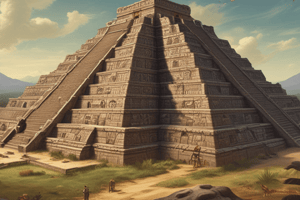Podcast
Questions and Answers
Flashcards are hidden until you start studying
Study Notes
Mexico City
- Modern Mexico City was built atop the ancient city of Tenochtitlán
- Tenochtitlán was the capital of the Aztec Empire (1300s-1400s)
- The Aztec Empire existed over 500 years after the Maya abandoned their cities
- The Aztec people migrated from the north to the Valley of Mexico by 1325 CE
- The Valley of Mexico was home to many groups competing for space
- The Aztec settled in the Valley of Mexico after being forced to leave several temporary homes
- The Aztec settled on two swampy islands in Lake Texcoco
### Aztec Food and Sustenance
- The Aztec utilized the lake's resources, harvesting fish, frogs, and algae.
- Hunting was practiced, with deer, rabbits, coyotes, armadillos, and snakes being primary targets.
- Domesticated animals such as turkeys, ducks, and bees provided additional sustenance.
- Insects like grasshoppers and worms were a part of the Aztec diet.
### Adapting to the Environment
- Chinampas, floating gardens, were constructed in Lake Texcoco to increase arable land.
- Bridges were built over marshlands to facilitate movement and trade.
- A diverse array of crops, including corn, beans, squash, tomatoes, amaranth, and chilies, was cultivated.
- The fertile Mesoamerican climate allowed year-round agriculture.
- Fruit trees were grown by the elite class in private gardens.
### Growth and Expansion
- The increasing food supply from diverse sources fueled the growth of Tenochtitlán.
Tenochtitlán's Layout
- Tenochtitlán's layout was based on a grid system.
- Streets and canals formed a pattern of squares.
- The city's religious and ceremonial center, the Sacred Precinct, was situated at the heart of Tenochtitlán.
- The Sacred Precinct was a pyramid-temple complex, larger than similar Maya centers.
- Stone walls adorned with serpent carvings encircled the precinct.
- The Great Temple (Templo Mayor) was the most prominent structure within the precinct.
- The Aztec dedicated shrines on top of the Templo Mayor to Huitzilopochtli (sun god) and Tlaloc (rain god).
Social Structure and Housing
- Social class played a significant role in Tenochtitlán's social life.
- Aztec priests resided in palaces within the Sacred Precinct.
- The emperor and nobility built carved stone palaces and gardens just outside the Sacred Precinct.
- Tenochtitlán was divided into four quadrants, each containing twenty calpullin (districts).
- Each calpulli encompassed its own farm, marketplace, and school.
- Commoners, including merchants, artisans, and farmers, inhabited the calpullin.
- Commoners built their houses from adobe (sun-dried clay bricks).
- Houses were typically one-story, featuring peaked thatch roofs or flat earthen roofs for gardening.
- Domed mud huts, used as sweat baths, often stood outside homes.
- Fires were lit outside the huts to heat the walls.
- Aztec people entered the hot huts and threw water against the heated walls to create steam for bathing.
Studying That Suits You
Use AI to generate personalized quizzes and flashcards to suit your learning preferences.



